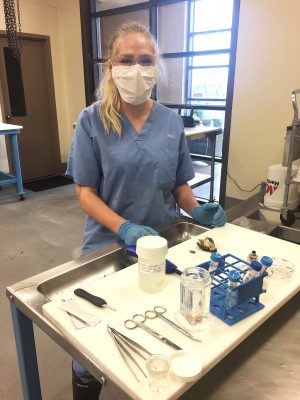
A second-year veterinary student returned to her home state this summer and not only honed her career path but is helping combat the number-one cause of illness and death in cattle worldwide.
Samantha Haller graduated with a degree in physiology from the University of Wyoming in 2017 and entered the College of Veterinary Medicine at Washington State University. She was accepted this summer into the diagnostic externship program in the UW Department of Veterinary Sciences.
The Cheyenne native has been working in the Wyoming State Veterinary Laboratory (WSVL) and conducting research into bovine respiratory disease complex (BRD).
“Ms. Haller has done well,” noted Donal O’Toole, a professor in the department who heads the diagnostic externship program.
He said Haller has been engaged in her project and with other work, such as examining diagnostic cases as she assists with animal autopsies.
“The quality of her work has been excellent,” he said. “She picked up the technical work surprisingly fast, under the supervision of staff in bacteriology and histology.”
The department has hosted veterinary students interested in veterinary diagnostics in externship programs since 1983. Haller entered the externship not knowing if she wanted to specialize or become a general practitioner. She’s figured out she wants to pursue pathology.
“Working with the pathologists here has been great, and they’re all such great teachers, and I’ve gotten a lot of hands-on experience,” said Haller.
Haller is a unicorn in the “what do I want to do when I grow up” crowd. She’s wanted to be a veterinarian since age 5.
“I was a shy kid, so I liked animals more than I liked people, and that’s the job you get to work with animals all the time,” she said. “I’m not a large animal person, so this is my first time in the large animal world. I’ve been wanting to get into it more.”
Haller said she job-shadowed a lot in pre-vet programs and would send away samples from diseased or ill animals but never know the results because she would not be at the facility the next day.
She also said working at the animal shelter in Cheyenne was difficult because she would see animals suffering medically or behaviorally and not know why.
“Here, they’re dead, their suffering is over, and you’re just trying to figure out the answer,” she said. “With large animals, a lot of the reason you are doing it is to figure out what’s going on so you can prevent that in the rest of the herd.”
The WSVL also tests large amounts of live animal samples. In 2019, the WSVL tested well over 100,000 samples from cattle in Wyoming and surrounding states.
BRD accounts for 65-80 percent of the sickness and 45-75 percent of the deaths in some feedlots, according to the Beef Cattle Research Council. BRD costs feedlots billions of dollars a year.
O’Toole said BRD is the most important single disease entity worldwide in terms of cattle illness and deaths.
“(Scientists) have figured out a lot about the main infectious players, but now there’s some bacteria that are maybe less common or a little bit harder to diagnose that are involved,” Haller said.
Her research looks at the roles of Histophilus somni and Mycoplasma bovis in past cases.
“Professor O’Toole and associate professor Kerry Sondgeroth have found both in more subacute to chronic bovine pneumonias, and they think it’s probably pretty under-diagnosed,” said Haller. “The point of my project is to go back and look through a lot of recently archived bovine pneumonia cases and establish whether one or both agents were present.”
She is using two methods on these pneumonia cases: PCR (polymerase chain reaction) and immunohistochemistry.
Preserved tissue is archived for 10 years after a diagnostic case is reported.
Histophilus somni and Mycoplasma bovis have been challenging to rank in terms of their importance in pneumonia, said O’Toole. “For technical reasons, they can be missed in routine diagnostic workups.”
Testing should determine if standard methods are sensitive enough to accurately identify all the major infectious causes of pneumonia in individual animals, he said.
“WSVL clients, including veterinarians and producers, need that information to be complete and accurate to inform decisions about vaccination and treatment,” O’Toole said.
He noted such a retrospective study would be impossible without support from the Kurt Swanson Bucholz veterinary science training fund.
“It requires someone like Ms. Haller who has a block of time and good hands to push it through,” he said.
The fund provided more than $13,500 in scholarship and for research supplies.
Kurt Swanson Bucholz was a veterinarian, legislator and longtime rancher in Wyoming. Among his numerous honors he was selected recipient of the 2006 Outstanding Agriculturist Award by the Wyoming Chapter of the Honor Society of Agriculture, Gamma Sigma Delta. He died later that year, age 56.
Haller, in addition to her work, has been answering questions from pre-vet students about vet school. She has advice for younger students looking to apply to veterinary schools.
“Don’t let anyone discourage you from applying,” she said. “I heard a lot of (from students) ‘vet schools are so hard to get into.’ It is competitive, but if you are doing the things you’re supposed to be doing, you’ll probably be fine. And also, just enjoy where you are at (in school). I had a great time as an undergrad, and I’m having a great time in vet school.”





